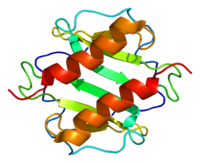
Photo from wikipedia
ETHNOPHARMACOLOGICAL RELEVANCE Abutilon pannosum is used in Pakistan for bladder inflammation, diuretic, lung disorders, diabetes and in lowering pyrexia. METHODS Amount of total phenolic content, total flavonoid content and HPLC… Click to show full abstract
ETHNOPHARMACOLOGICAL RELEVANCE Abutilon pannosum is used in Pakistan for bladder inflammation, diuretic, lung disorders, diabetes and in lowering pyrexia. METHODS Amount of total phenolic content, total flavonoid content and HPLC analysis of APM for the presence of polyphenolics were carried out. Antioxidant activity was determined by using different in vitro antioxidant assays. Amelioration effects of APM (200 mg/kg body weight and 400 mg/kg body weight) against CCl4 induced kidney and lung toxicity in rat was assessed by determining level of antioxidant enzymes, lipid peroxidation products, cytokines (TNF-α, IL-1β and IL-2), comet assay and histological analysis. RESULTS HPLC-DAD studies of APM indicated the presence of rutin (0.635 ± 0.011 μg/mg dry extract), gallic acid (1.07 ± 0.043 μg/mg dry extract) and catechin (0.246 ± 0.08 μg/mg dry extract) and considerable quantity of total phenolic (55.485 ± 0.85 mg GAE/g dry extract) and total flavonoid content (19.90 ± 0.58 mg Rutin/g dry extract). During in vitro antioxidant assays APM showed significant (p < 0.05) activity for iron chelation, reducing potential, inhibition of β-carotene oxidation while moderate potential for scavenging of DPPH, hydroxyl, nitrite and phosphomolybdenum radical. Administration of CCl4 to rat severely depleted the activity level of catalase (CAT), peroxidase (POD) and superoxide dismutase (SOD), and reduced glutathione (GSH) concentration while appreciably increased the concentration of thiobarbituric acid reactive substances (TBARS), H2O2, nitrite, TNF-α, IL-1β and IL-2 in lung and kidney tissues of rat. Comet length, % DNA in tail and tail moment significantly (p < 0.01) increased in lung and kidney cells of CCl4 intoxicated rat. Further, injuries in lung and kidney tissues were recorded with CCl4 induced toxicity in rat. The rats treated with APM along with CCl4 exhibited an appreciable level of restoration of the altered parameters towards the control animals. CONCLUSION The results of this study suggested the protective potential of APM in CCl4 intoxicated rats for kidney and lung injuries.
Journal Title: Journal of ethnopharmacology
Year Published: 2019
Link to full text (if available)
Share on Social Media: Sign Up to like & get
recommendations!